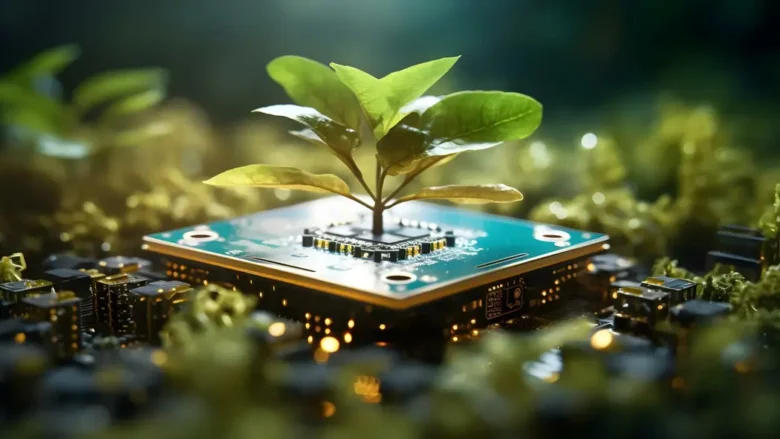The IT industry is embracing the challenge of reducing pollution and waste as people become more environmentally conscious. The rise of biodegradable technology represents a giant shift in sustainable development, offering a more environmentally friendly alternative to traditional electronic devices. Companies are exploring materials that can break down organically without harming the environment for use in everything from mobile phones to packaging. This movement not only supports international efforts to combat climate change but also aims to address the growing challenge of e-waste. As people look for environmentally friendly solutions, biodegradable technology has the potential to entirely change the way we use devices. Let’s take a look at how this fascinating trend can contribute to a better, cleaner future.
Biodegradable Technology: What is it?
Electronic components and systems made from materials that can naturally break down over time are called biodegradable technology. These materials break down into harmless compounds once removed, in stark contrast to traditional metals and plastics that end up in landfills for generations. Bioplastics made from cornstarch, printed circuit boards made from algae, and even packaging made from mushrooms are just a few examples. Researchers are also developing biodegradable batteries and sensors that can break down after use. By reducing the environmental impact of electronics, this invention offers a sustainable alternative to the hazardous waste generated by traditional technologies.
Importance of Biodegradable Technology:
With millions of tons of discarded electronics ending up in landfills each year, the environmental impact of e-waste is alarming. These items release toxic chemicals into soil and water, which harm human health and ecosystems. Biodegradable technology helps alleviate these problems by ensuring that discarded devices break down safely. It also promotes a circular economy by reducing reliance on finite resources such as rare earth metals. As climate change accelerates, the use of sustainable technology is essential. Using biodegradable electronics is a proactive way to reduce harm and protect the environment for future generations.
Innovations in Biodegradable Technology:
Recent developments are bringing us closer to a world without electronics. To produce environmentally friendly displays and chips, scientists have developed biodegradable semiconductors using organic ingredients. Some companies are experimenting with edible electronics, including sensors made from gelatin or rice that dissolve in water and are harmless to the human body. The use of plant-based cellulose nanofibers to create flexible, biodegradable printed circuit boards is another promising development. These innovations show that it is possible to develop high-performance technology without harming the environment.
Challenges to Popularizing Biodegradable Technologies:
Biodegradable technologies hold great potential, but their widespread adoption faces challenges. It remains an issue, as many environmentally friendly materials degrade faster than traditional materials, which can shorten the lifespan of the device. In addition, production costs are higher, which increases the purchase price of biodegradable devices for users. We also need to improve the recycling infrastructure to effectively manage these new materials. Policymakers, manufacturers, and scientists must work together to overcome these obstacles. With continued investment and innovation, biodegradable technologies can overcome these challenges and become widely adopted.
Consumer Contribution to Change:
The shift to biodegradable technology is largely driven by consumer demand. As more consumers place greater emphasis on sustainability, companies are encouraged to work on developing greener products. Small things, like promoting companies that use environmentally friendly products or properly disposing of old electronics, can have a big impact. Understanding the impact of electronics on the environment can help consumers make informed decisions. By working together to support sustainable technologies, people can potentially push the industry to be more responsible in the future.
Conclusion:
The development of biodegradable technology is revolutionizing the way we produce, use, and dispose of electronics. By using environmentally friendly materials, we can significantly reduce e-waste and its negative impact on the environment. Although there are still challenges to overcome, the encouraging progress to date demonstrates that sustainability and innovation can coexist harmoniously. As more people, companies, and governments support this effort, the goal of a cleaner, greener planet becomes closer. Technology is not only getting smarter; it’s also getting greener. Let’s embrace this shift and create a future where technology improves the ecosystem instead of destroying it.
FAQs:
1. Can biodegradable electronics last as long as traditional electronics?
While the performance of biodegradable materials is improving, they generally don’t last as long as traditional metals and plastics. Scientists are working to make them more sustainable without sacrificing environmental friendliness.
2. How quickly do biodegradable technologies degrade?
Compared to traditional polymers, which take decades to degrade, most biodegradable electronics degrade in just months to years under the right conditions.
3. Will biodegradable technologies cost more?
Yes, initially using environmentally friendly products and processes will increase costs. However, as production increases, prices are expected to become more competitive.
4. Can biodegradable electronics be recycled?
While some components are biodegradable, others can be recycled. To effectively process these materials, changes in proper waste management practices are needed.
5. Which industries are leading the way in biodegradable technology?
The consumer electronics, medical, and packaging industries are leading the way, with companies testing everything from biodegradable phone cases to dissolvable medical implants.




